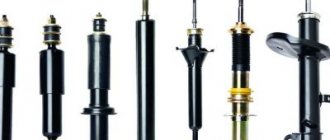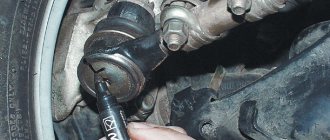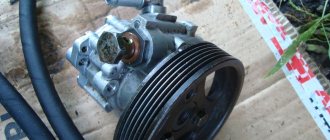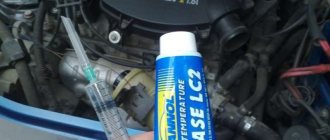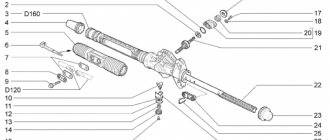Extraneous sounds, noises and even rattles are an integral part of any car after many years of operation. It is sounds and humming that are uncharacteristic of driving that can be considered clear signs of a breakdown or malfunction in any component of the vehicle.
In most cases, grinding and creaking do not indicate breakdowns, but the incorrect (faulty) operation of some mechanism. Often these problems are only detected under certain conditions - for example, when turning the steering wheel.
Front stabilizer
If the stabilizer link partially fails, a dull knock is heard when the wheels turn while moving. Moreover, the wheels begin to knock if they are turned to one side or the other at approximately 50...60%. However, a faulty strut itself can creak not only when turning, but also when the car is moving on an uneven road. Often the car also “fidgets” on the road, that is, it is necessary to constantly control (twist) the steering wheel. Additional signs - the car body rolls too much when entering a turn and sways when braking.
Causes of knocking and solutions
Diagnosis of problems with the steering wheel
- A failed ball joint. In this case, it may simply burst. This entails the wheels turning inward or outward in an unnatural way. The car is unable to move on its own. The only way out is to replace the hinge with a new one.
- A failed grenade. If a knock is heard when turning the steering wheel to the right, then the left grenade is loaded. Naturally, to solve a problem such as a knocking noise when turning the steering wheel to the left, you should replace the right grenade and vice versa.
- Wear of stabilizer bushings. To solve the problem, you need to purchase silicone grease and simply spray it on the bushings.
- Steering rack malfunction or weakening. Diagnostics will help identify the problem and repair/replace the spare part.
- Loosening the engine crankcase protection bolts . To do this, you need to tighten the bolt, or replace it if the thread is broken. It is rare that a tap needs to be used to create a new thread.
- It is possible that after replacing the wheel the nut was not tightened properly , then a knocking noise may appear after an unsuccessful replacement, and over time it increases with vibration. The solution is to tighten the nuts to the desired torque.
- Considering the quality of spare parts and the conscience of sellers, a spring can easily burst . The solution to the problem lies in replacing it with a new spring.
- Leaking shock absorbers are another reason for the appearance of a characteristic knocking sound when the car squats. Replacing with a new shock absorber will help solve this problem.
Why is grinding heard and how to deal with it
If you hear a grinding noise when you turn the steering wheel, this indicates wear on the steering system joints or front suspension. To find out the exact cause, it is worth carrying out diagnostics at a service station and replacing the failed spare part.
Article on the topic: Gasket for the fuel pump: which is better
Noise can occur when turning the steering wheel: a grinding sound when driving, or when the car is stationary. The cause of this noise lies in the failure of the support bearings of the strut or lower ball joint.
If you hear a grinding noise in the wheel when you turn the steering wheel, there can be many reasons. Experienced drivers advise contacting a car mechanic, driving the car into an inspection pit and having a look. Among the reasons are:
- The rubber on the cardan outboard bearing is torn. Stones and rubble can get into it;
- The grinding noise may occur when the pads rub against the discs;
- Another reason could be a loose locking ring.
In sub-zero weather, when turning the steering wheel all the way, a grinding noise is heard due to lack of lubrication. In this case, additional application of lubricant will help.
How to remove the steering wheel from a Lada Kalina
When the steering wheel on Kalina sticks, you need to disconnect the negative terminal of the battery and wait about 10 minutes for the airbag activation capacitor to discharge. The two latches and cushion latches should be released.
There are holes on the sides of the steering wheel. If the steering wheel was not removed, they are sealed. After removing the seal, use a flat tool to find a stop with a spring in the vacated opening. Squeeze the latch with one hand and pull the pillow toward you with the other until it clicks. If the cushion does not return to its place, the latch has become loose. Do the same on the other side.
The released cushion should be moved slightly. A pair of audio signal wires are disconnected by using a flat object, maybe a knife, to pry off the small yellow clip from the orange connector of the airbag. It is moved forward, the connector is removed, the pillow is released and set aside.
Then you need to find a small arrow on the shaft and make a mark opposite it for the correct orientation of the steering wheel. Loosen the steering wheel nut, but do not twist it all the way, leave about two turns. Using the method of swinging towards yourself, tighten the steering wheel until it stops against the nut. Align the wheels of the car and ensure that the steering wheel is installed straight. Remove the pin, connect the marks and insert it into the switch block under the steering wheel.
Under no circumstances allow the steering wheel to move, otherwise it can be broken off along with the base of the block, unscrew the nut. Pull the wires through the outlet and remove the steering wheel on Kalina.
We now know how to remove the steering wheel. When reassembling, all steps are performed in reverse order. Don't forget about the little things that are so important for proper installation of the steering wheel.
Other reasons
When the driver realizes that his steering wheel is creaking when turning, he begins to look for the cause. However, the malfunction may lie in different elements of the car system. Specific car brands have their own specific reasons, which are not discussed in this article. The variety of steering systems is so great that there are many causes of malfunction.
In any case, whatever the cause of the problem, it must be eliminated as soon as possible. And it will be good if a professional does this. It's best to see a mechanic as soon as you notice any warning signs that could indicate a problem with your power steering or other critical components. Underestimating minor problems can lead to their aggravation and complete destruction of the system, which is associated with expensive repairs.
Knock (the steering wheel turns, but there is play)
Typically, the joints found in the steering system last as long as your car drives. However, under Russian operating conditions, faster wear is possible. Turning the steering wheel, accompanied by a faint knock at the beginning of rotation, indicates that the hinges are worn out (an increased gap has appeared). If you park the car on a level surface, then try to rotate the role from right to left, then from left to right (you need to start carefully with small movements), you can identify at what point in time the play and knocking sound appears. You can improve this method a little - open the car doors, then with the doors open, while outside the car, gradually turn the steering wheel from side to side. At some point in time, you will notice that the steering wheel rotates, but the wheels do not move - this means there is play. This backlash needs to be eliminated.
This can be done by diagnosing the hinges at a car repair shop (you need to check for wear and play), after which you need to replace the worn elements and tighten the necessary components that are causing the play.
When the shock absorber is faulty
Sometimes the cause of the noise is the creaking of the support bearing when turning the steering wheel. If creaking and howling noises occur no matter which way you turn, check the shock absorbers. Often the problem is in the bearings of this unit. It may be enough to remove any dirt that has clogged up under the boot. How to diagnose? Read on.
Try turning the steering wheel while standing still. Even better, ask an assistant to “steer”, while you listen and watch the movement of the shock absorber spring into the gap between the upper edge of the tire and the wing arch. If the part turns jerkily, as if something is interfering with it, it means that the support bearing creaks when turning the steering wheel. It's simple. There is no movement - neither the transmission nor the hubs can make noise - the shafts and wheels do not rotate. In this case, the only thing to suspect is the shock absorber struts.
Causes of creaking rack and steering column
If the steering column is not working properly, you will hear a slight knock and noticeable vibration when driving. The cause of this malfunction is a strong mechanical impact on the steering wheel, during sudden braking or a collision during an accident. Such signs indicate deformation of the steering column. Also, strange sounds may come from the coupling.
Of course, the best way to eliminate a squeaking or knocking sound when moving and turning the steering column is to simply replace the non-functioning element with a new part. Unfortunately, the steering column is expensive, which means you need to look for ways to repair the old part. Vibration and noise can be eliminated using lubricant. Lubricating the driveshaft with a small amount of grease can eliminate unwanted noise, but this will only mask the symptoms. It is important to seek help from professionals who can fix the broken part before it completely fails.
Steering knuckle bearings
If, when turning the steering wheel, the driver hears an uncharacteristic squeak, which can sometimes appear quite suddenly, it is worth listening to the steering knuckle.
When the sound comes from there, the cause most likely lies in worn bearings.
These bearings can squeak and make cracking noises if there is no lubricant inside or if sand or other abrasive contaminants have entered the housing.
Untimely replacement can have dangerous consequences. It is recommended to remove the bearing from the steering knuckle and check it for defects. If they are not there, lubricant is added and the part is returned to its place. If defects are detected, a new bearing similar to the previous one is used.
Replacing the ball joint
Tool for work:
- wrenches 17, 19;
- hammer;
- mount;
- puller;
- head for 12.
The ball joint is being replaced
The car is put on the handbrake, the bolts of the wheel from which the ball joint will be removed are loosened. Using a jack, the front part of the Lada Kalina car is raised, the bolts and wheel are removed. Use a 19 wrench to unscrew the ball pin nut. Insert the puller and twist to release the support pin.
The support fastening bolts are removed using a 12mm socket. The lever is pressed down, the support is released and removed. There is another way to dismantle the ball joint: the brake disc is placed on a rigged brick, the jack is lowered slightly to relieve the lever. At this moment the rack rises up, the ball is released.
A large amount of lubricant must be added to the new support. The pin is put in place, the nut is tightened with a torque of 66-82 Nm. If the holes of the steering knuckle and the support coincide, the bolts are tightened. The procedure requires patience and considerable effort.
Problems with the steering rack
The main reason for annoying squeaking noises when turning the steering wheel is a faulty steering rack. Such a squeak can be annoying, and untimely repairs can damage the parts. Unwanted squeaking can occur due to simple wear of the mechanisms, damage to the rack box or wear of the steering tips, which can rub against the rods. In addition, damaged anthers can accumulate dirt and debris, which makes a nasty sound when the mechanism operates.
Also, the cause of an unwanted squeak may be an incorrect setting between the steering rack and the column. It is extremely difficult to make such an adjustment, since all machines have an individual adjustment system, and it is better to trust a specialist.
How to diagnose?
Why do you hear a rubber squeak when you turn the steering wheel? To answer this question, you need to check all possible reasons. It can squeak anywhere. Therefore, when carrying out diagnostic actions, be sure to clarify where the sound is coming from. This will make it easier to find the breakdown. But even after identifying the reason, check all other details. They may also be damaged. To identify the source of the squeak, you need to drive the car into an inspection hole. The assistant turns the steering wheel, and you listen to where the sound is coming from.
Wheel alignment angles
. If the squeak comes from the rubber, and only when driving while the car is stationary. The reason is most likely due to incorrect wheel installation. Visit a service where there are specialists in such adjustments. Do not delay in eliminating the cause. An incorrect installation angle leads to uneven tire wear. Moreover, they can become completely unusable quite quickly.
Steering column
. It is easy to establish that the creaking comes from it. The sound will be superficial, and you will often feel vibration and impacts in the steering wheel. The column coupling may creak. Just lubricate it and everything will be back to normal. Often the cause of a squeak is a bent steering column. The problem arises after accidents and unsuccessful repairs. This can only be eliminated by replacement. But this does not affect the driving performance. If the noise is not strong, then you can drive without fear.
Steering rack
. It rarely creaks. But this still happens. The creaking can be produced by the articulation of the rack and column. This happens due to wear or simply poor adjustment. First, try adjusting the mechanism. But this is not possible on all car models. Therefore, start by studying the manuals on this issue.
Tie Rod Ends
. These parts creak if the boot is damaged. In this case, dirt and sand get into the finger. This is what causes the creaking. Moreover, this sound can appear not only when driving, but also when driving over uneven roads. The problem is identified visually by inspecting the tips. It is recommended to change these parts on both sides at the same time.
Silent blocks
. These suspension elements usually begin to creak in extreme heat. And this is not always a sign of their malfunction. This is the first symptom of a future malfunction. Typically, this manifests itself on parts made of rubber. It dries at high temperatures and shrinks slightly in size. This is why there may be a squeaking sound.
To avoid this, it is recommended to install polyurethane parts. If such a squeak appears, carefully inspect the silent blocks. If there is no visible damage to the part, you can continue driving. As the temperature drops, this unpleasant symptom will go away.
Bearing problems
. The bearing in the steering knuckle will squeak. This also occurs when turning the steering wheel. A squeak appears when there is a lack of lubrication or grains of sand get into it. At the same time, the bearing may heat up, but this is not necessary. Add lubricant and adjust it.
Plastic
. The steering column of a modern car is located in a plastic, decorative casing. On budget models, the plastic is prone to crickets. Therefore, when you turn the steering wheel, various sounds may appear. This can be eliminated in various ways. It all depends on the car model.
Sounds on cars with hydraulic booster
The power steering mechanism consists of the same parts and trapezoids, only the rack has special oil channels. Through them, oil under pressure acts on the steering rods, which makes it easier to turn the wheels.
– wear of the impeller of the power steering pump itself;
– jamming of the power steering pump;
– broken boots in the steering rack (it will start to leak);
– wear of the power pump drive pulley.
This kind of trouble happens even when the steering is working properly. In a strong eversion of the wheels, the load on the power steering pump becomes large. Especially when the car is loaded. The sound occurs due to increased wear on the drive pulley or belt.
Service
In order for the steering to work properly, the driver must know how to properly maintain and operate it. To do this, you should carry out maintenance: change the oil in the power steering pump, if the tips or steering rods are worn, replace them with new ones, check the wheel alignment and adjust them if the angles do not match. Spare parts and oil must be from high-quality and original manufacturers. During operation, the driver must monitor the condition of the steering and the proper operation of the hydraulic or electric booster.
Tie rods and tie rods
Due to natural wear and tear, the lugs and rods may, over time, become loose and squeak and make knocking noises when turning the machine. To diagnose, you need to jack up the car on the side where the annoying sound is coming from and first remove the wheel. Next, you need to shake the rods and tips and check for any play in them. It often happens that the boot on the tip breaks, which means dirt and moisture gets inside. This causes a corresponding knock.
There are cases when, for example, when performing a wheel alignment operation, a car enthusiast or master forgets to tighten the fastening nut between the steering rod and the steering tip. Accordingly, when you turn the steering wheel, both in motion and at a standstill, a loud metallic knock will be heard. You can determine more precisely if you shake the front wheel left and right with your hands, it will dangle and make similar sounds.
Ball and CV joints
The ball joint, or rather its wear, can cause squeaks and knocks when turning the steering wheel, both in place and in motion. It is better to change the support immediately, because the danger of its complete failure at high speed is very, very high. The key to long service life of ball joints, like many other components of a car, is adequate driving, especially on roads that are so called, quite arbitrarily. Well, keeping an eye on the condition of the anthers can also significantly extend the service life of these units.
CV joint or constant velocity joint is directly involved in the transmission of torque from the gearbox to the wheel. And just one of the signs of CV joint failure is a crunching sound when turning the steering wheel; this is the needle bearing complaining of its hard lot. CV joints can be external and internal and, as a rule, it is the external hinges that crunch. If you know for sure that the cause of the crunching is in the constant velocity joint, then you should not panic right away. Sometimes the CV joint crunches five or even ten thousand kilometers and only then does it become necessary to replace it. Or perhaps you should change the boot, renew the CV joint lubrication and it will last for quite a long time.
Elimination method
The method for eliminating squeaks when turning the steering wheel is quite simple. First you need to find the cause and element that makes extraneous sounds. If the outer hinges are worn, they should be replaced. If the front wheel bearings are worn out or the hub nut is loosened, these fasteners must be tightened and the bearings replaced.
In cases where a spring creaks when turning the steering wheel in different directions, it means that it is broken. It needs to be replaced, and it is advisable to do it in pairs at once.
If the steering wheel, steering column bracket, steering mechanism, rack adjusting bolt, steering rod ball pins, or bolts securing the lower flange of the elastic coupling on the gear shaft make knocking noises when turning the steering wheel due to loose fastening, then tighten the threaded connections and adjust the steering column.
Common causes of squeaking noise when turning the steering wheel
Here are the most common reasons why you hear a squeak when turning the steering wheel.
Wheel alignment performed incorrectly
If you hear squeaking noises from your tires, and it mostly happens when the car is stationary, there is a good chance that the problem is due to improper wheel alignment. In this case, it is necessary to perform a wheel alignment as quickly as possible to correct the problem.
Incorrect wheel alignment angles negatively affect the tires, which begin to wear unevenly and fail much faster than they should.
Silent blocks creak
A common problem that is often encountered in hot weather. If silent blocks begin to creak at high ambient temperatures, this is the first “bell” that they will soon fail.
The creaking of silent blocks in hot weather is due to their drying out. Since the main working material of silent blocks is rubber, at high temperatures it “dries out” and decreases in size, especially if we are talking about relatively old parts.
There is no danger in the creaking of silent blocks until the part breaks. Remove the silent blocks and carefully inspect them for cracks and various types of damage. If there are no visible problems, you can put them in place and continue driving, hoping that soon the air temperature will drop lower and the squeak will disappear.
Please note: For many modern cars you can find silent blocks made of polyurethane, which is not subject to the problem of “drying out” in the heat.
Bearings squeak
If you hear a squeaking, squeaking, or crackling sound from the steering knuckle when you turn the steering wheel, this most likely indicates a bearing problem. They behave in a similar way if there is not enough lubrication for their proper operation or if there is sand (or other foreign element) in the bearing.
Bearing creaking must be eliminated as quickly as possible so that the part does not fail completely. To do this, remove the bearing and inspect it for damage. If they are not found, then lubricate the part, install it in place and adjust.
Please note: When the squeaking of a bearing is caused by foreign elements entering it, be sure to find the reason for their entry into the part.
Steering rack or steering column creaks
It is quite simple to determine the creaking of the steering column by the characteristic vibration, which will also occur when the steering wheel rotates. Most often, the steering column clutch squeaks, and this problem is typical for cars that were unsuccessfully restored after a serious accident. This problem, if the noise is not strong, does not affect the quality of the steering mechanism, so you can continue to operate the car. The situation can only be corrected by replacing the steering column.
Also, a squeak can be heard from the steering rack and column joint if they are poorly adjusted or there is severe wear. Depending on the car model, this problem can be solved in different ways. Most often it is possible to adjust the mechanism.
Tie rod ends squeak
Due to damage to the anthers, foreign elements get into the tie rod end pin, which leads to squeaks both when turning the steering wheel and when overcoming obstacles. To determine if there is a problem, you need to inspect the tips, and if sand or other foreign matter actually got into them, you will need to replace them, and it is recommended to change them in pairs.
The plastic casing creaks
Every driver knows that when actively using a car that is not of the best build, “crickets” will appear over time. They represent creaks of the front panel, including the steering casing, made of plastic. This problem is solved in various ways, depending on the car model.
If all the parts described above have been inspected and the cause of the squeak cannot be determined, it is also recommended to check the power steering drive belt and brake elements, especially the pads and discs.
Crunching sound (steering wheel turns when driving; car with front-wheel drive)
It happens that when the direction of movement of the car changes, a strong crunching sound is heard. The greater the turning speed and the narrower the radius, the more pronounced it is. There is a feeling that the steering wheel does not play any role here, and that it is the turn itself that is to blame, that the crunch is heard in the area of the loaded wheel (remember that this is the wheel from the outer radius of the turning curve). Most often, this picture is characteristic of turning only in one direction.
Only all-wheel drive vehicles or vehicles with front-wheel drive suffer from such problems. The culprit for this is the constant velocity joint, which in our country is called the “grenade”.
This hinge is a prefabricated element that serves to rotate the front wheel along any axes at a certain angle, without losing the constant speed of the axle. When the car moves, the CV joint rotates all the time, experiencing heavy loads. From time to time, this part runs out of service prematurely, in which case it will need to be replaced.
Checking the “grenade” looks like this. The steering wheel must be turned to one side all the way. After this, you should start moving the car in a circle - in one direction, then in the other. The crunching noise heard during such an operation means that the CV joint is the culprit. If there is vibration that may accompany such a crunching noise, the car must be taken to a professional mechanic without delay.
The so-called boot protects the CV joint from dirt and dust. Often, wear of the “grenade” occurs due to damage to the boot. Actually, the sound of a crunch means that either particles of sand or dirt have penetrated through the boot into the CV joint and the joint begins to grind it all, or the crunch is caused by the collapse of the bearings inside the CV joint.
The machine is not the simplest mechanism. Its steering system and suspension include a huge mass of elements. The suspension and steering differ in their functionality, design, and elements (and differences may appear from model to model; differences may even exist in modifications). For this reason, various noises do not need to be produced only for the reasons described above. For example, noise can be caused by the steering rack, steering column, steering knuckles, struts and joints. An old, falling-off element, which is not directly related to either the suspension or steering, can touch parts of the above systems during a turning maneuver or on road irregularities, causing noise.
In any case, the main thing you need to do when you hear an extraneous sound accompanying the turning of the steering wheel is to determine the other signs accompanying the noise (the car is pulling to the side, a more specific definition of noise). After this, it is necessary to check each boot of the suspension and steering systems, inspect the steering wheel, and check for play.
Reading time: 4 minutes
The driver of a car, turning the steering wheel, sometimes hears extraneous sounds coming from the front of the car. Sometimes they don’t mean anything, but in some cases, when you hear a grinding sound in the wheel area when turning the steering wheel, we are talking about serious problems.
Noises from power steering
Despite the fact that electric power steering is being introduced very often today, the main driver assistant when steering in most passenger cars remains power steering. This unit may make noise due to a lack of working fluid. In this case, you need to add it to a tank specially designed for this purpose. Just add the same liquid that the manufacturer used, the amplifier itself is configured specifically for the operating parameters of a particular product, and the use of a different liquid can be very negatively perceived by the amplifier. In addition to the lack of working fluid, the cause of noise in the power steering can be its pump, if it is about to die, you also need to check the condition of the power steering belt, because certain difficulties can also arise with it. And if the condition of the power steering belt makes you suspicious, it is better to replace the belt.
: when braking in a car - why and what to do?
When turning the steering wheel, a grinding noise is heard in the wheel area
What could be the reason
When you hear squeaks, grinding noises, or crunching noises from a wheel when turning, this may be due to one of the following reasons:
- Due to long-term use, the steering rack wears out. It is possible that the noise is due to the fact that the fastening is loose.
- This result is caused by a faulty steering column.
- If the shock strut bearings need replacing or have bad ball joints, this is also a possible cause of the noise.
- The drive mechanism must operate in clean conditions, but if the anthers rupture, dirt will get inside and disrupt its operation.




